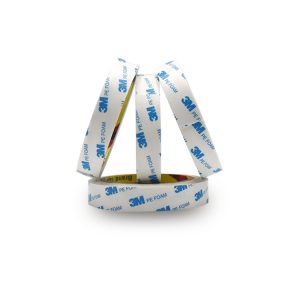携帯電話の裏表紙の接着における接着剤(PEフォームテープ)
xinst2020年6月18日
In the process of assembling mobile phones, various adhesives (pe faom tape)are used. For the bonding needs of different parts in mobile phones, the adhesives used are also different. Next, let's take a look at the adhesive in the bonding of the back cover of the mobile phone. In addition to the reliable bonding, what other requirements are there.

Our lives today are inseparable from smartphones. Research agency Canalys predicts that smartphone shipments in 2019 will decline by 3.1% to 1.35 billion units year-on-year, mainly due to widespread uncertainties. With the arrival of the 5G mobile phone replacement wave, Canalys predicts that smartphones will achieve positive growth in 2020, and global shipments are expected to rebound to 1.39 billion units, an increase of 3.4% year-on-year.
In order to reduce the thickness of the mobile phone, one of the solutions adopted by the mobile phone designer is to replace the previous buckle design with the back cover and the middle frame. Of course, according to the needs of the design of the mobile phone, the bonding solution is also different.
From the material point of view, the current material of the back cover of the mobile phone is mainly glass and plastic, supplemented by ceramics, and niche varieties of leather and carbon fiber. As an emerging back cover material, ceramics have excellent appearance/feel, but because of the high cost, low yield, and fragility, a large number of applications have been limited. The PC+PMMA composite sheet prepared by co-extrusion technology has the characteristics of excellent appearance/hardness, etc. It is currently the best solution to replace glass. It has been widely used as a back cover, but the current production capacity is limited, the product is easily deformed, and the yield is low. The investment risk is large, and there is not much room for process improvement and cost reduction. The internal stress and deformation caused by the plastic sheet in the process have a great influence on the back cover bonding. If the internal stress is large and the deformation is large, there is a high requirement for the anti-warping performance of the tape.
In terms of shape, 3D has slowly replaced 2.5D due to its good grip. The 3D glass process is very mature, but due to the relatively high cost, many mobile phone manufacturers use the 3D composite sheet (PC+PMMA) solution instead of the glass solution.
Since the back cover of the mobile phone is in direct contact with the outside world and is susceptible to various external forces, the adhesive for bonding the back cover is required to be high. It requires the mobile phone to undergo low temperature storage (-40℃), high temperature storage (70℃), high and low temperature cycle (-40℃~70℃), high and low temperature impact (-40℃~70℃), high temperature and high humidity after assembly (60°C, 90%), directional drop (1m or 1.5m height, 6 cycles, 4 corners, 2 cycles) and roller drop (0.5m or 1m drop corresponding times), the back cover and the middle frame are still firmly bonded, not Significant lifting and separation will occur. In addition, some high-end models need to achieve a higher level of dust and water resistance, such as IP68. In addition to reliable bonding, mobile phone manufacturers also require adhesives to be easily reworked and removed.
方向落下試験機、ローラー落下試験機
携帯電話の設計のニーズに応じて、設計者はさまざまな異なるボンディングソリューションを使用します。
2.5Dガラスの背面カバーは、PEフォームテープでミドルフレームの表面に接着されています。 このデザインは、バックルソリューションではなく、第1世代の携帯電話の背面カバー接着ソリューションです。 利点は、携帯電話の厚みが薄くなることです。 信号シールドを低減するために、以前の金属の代わりにガラス材料が使用されています。 しかし、以下の欠点は、分解が容易ではなく、落としたときに壊れやすいことです。
Some designs use a 2.5D or 3D plastic sheet to be glued to the surface of the plastic buckle frame, and then fix the plastic buckle frame to the middle frame. The advantage of doing so is to facilitate the removal of the back cover, but it will increase the thickness of the phone. In order to meet the requirements of mobile phone feel, texture and thickness, high-end mobile phones generally adopt the scheme of bonding the 3D glass back cover to the surface of the middle frame through adhesive tape.
There is no shading requirement for the adhesive for bonding the back cover of the mobile phone, but it cannot affect the appearance of the mobile phone, so it is generally black. The thickness is generally 0.25 ~ 0.4mm, usually 0.25mm/0.3mm/0.35mm/0.4mm. The recent appearance of the Unibody process, that is, the integration of the PC injection mobile phone back cover and the middle frame may cause the thickness of the tape to further increase. The bonding width is relatively wide, generally 1~2.5mm, there is a need for rework and maintenance. Some designers use glue solutions for bonding reliability, such as the two-component acrylic glue solution. Most designers choose tape solutions. For the bonding of 2.5D glass back cover, general foam tape can be used to meet the requirements, but due to the low cohesive strength of PE foam tape, it is easy to damage cohesively when directionally dropped, resulting in a high glass breakage rate. The 3D design will make the gap between the back cover and the middle frame have a larger tolerance, and there is a risk of the back cover warping deformation and poor sealing, so the tape needs to have very good anti-warping performance and sealing performance. Generally use PE foam double-sided tape or VHB tape. The anti-warping performance of the tape is related to the design of the top rubber and the choice of foam.
PEフォーム両面テープとVHBテープはどちらも 、接着界面でのシール性を確保しますが、前者は連続気泡フォーム、後者は独立気泡フォーム、後者はより優れたボディシール性を備えています。 どちらも優れたクッション性能を発揮しますが、前者は密着性が悪いため、落下時に剥離しやすくなります。 後者は凝集性が高く、落下時に凝集性の損傷がないことを保証し、後者は再加工時にきれいに取り除くことができますが、前者はほとんどきれいに取り除くことができません。
2020年は5Gの時代だと言う人もいます。 5G技術の急速な発展と5G基地局の建設の加速とともに、スマートフォン部品のさまざまな材料も絶えず開発されています。 同時に、スマートフォン向けのより高度なボンディングソリューションが提案されています。 要件、裏表紙の接着も例外ではありません。 携帯電話メーカーはまた、携帯電話の設計サイクルに遅れずについていき、需要を満たすために顧客の期待に応える、またはそれを超える接着剤を設計する必要があります。


